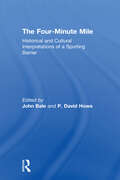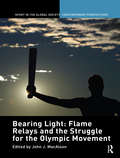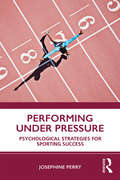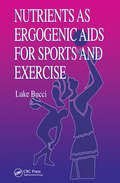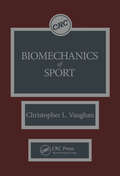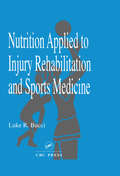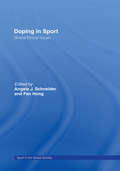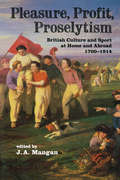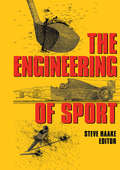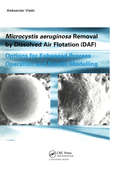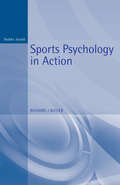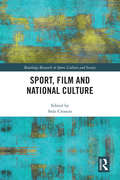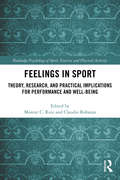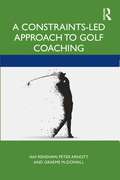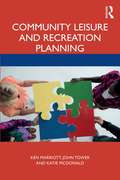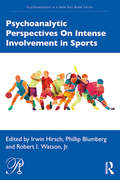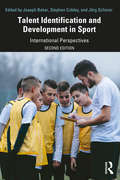- Table View
- List View
The Four-Minute Mile: Historical and Cultural Interpretations of a Sporting Barrier
by John Bale David HoweBreaking records and challenging the limits of human ability are central to much of our understanding of athletic track and field sports, with a world record title arguably as valued as an Olympic gold medal. Some particular limits and records take on greater significance, however, as in the case of the Four-Minute Mile which was roundly believed to be impossible until Roger Bannister shattered the illusion with half a second to spare in May 1954. These essays look at the background of Bannister’s achievement and the meaning that was ascribed to it by the media and the public at large, drawing on an array of interdisciplinary and international influences to unpick the legend surrounding an historic moment in our social and sporting past.
Bearing Light: Flame Relays and the Struggle for the Olympic Movement
by John J. MacaloonThe Flame Relay and the Olympic Movement is the first book-length scholarly study in English of the contemporary Olympic flame relay. Reporting for the first time on years of intensive ethnographic research and organizational intervention, MacAloon literally follows the Olympic flame through twenty years of intercultural encounter, conflict, and negotiation. Focusing on the frequently harmonious, sometimes perilous encounters among Greek flame relay officials, cultural agents, and discourses, foreign Olympic Games organizing committees, and such transnational actors as the IOC and its corporate sponsors since 1984, a context is created for understanding the significance for the Olympic movement and for globalization studies of the 2004 Athens flame relay, the first to travel the entire world. Through intensive interviews and co-participations with leading Greek and American actors and the contributions of young Greek researchers who worked backstage on the relay, Bearing Light demonstrates how culturally parochial the managerial regime of "world’s best practices" often turns out to be and yet how inescapable it has become for those who wish to communicate across cultural and political boundaries. This dilemma, the contributors argue, constitutes the practical form in which the struggle to preserve a sense of "Olympism" and "the Olympic Movement" against the demands and prerogatives of today’s Olympic sports industry is being chiefly fought out.This book was previously published as a special issue of Sport in Society
Performing Under Pressure: Psychological Strategies for Sporting Success
by Josephine PerryPerforming Under Pressure is an essential resource on improving sporting performance in high-pressure situations. Perry’s work guides coaches and athletes through nine key elements of the sporting mindset to help athletes to perform at the highest standards, even under the most pressurized of situations. This valuable read includes empirically-based advice on areas such as embracing competition; building confidence, concentration and focus; maintaining emotional control; learning from and coping with failure or injury; being braver; and being able to push harder. Perry also provides 64 strategies to support each sporting mindset, offering not just the evidence as to why they work but exactly how to implement them. This book uniquely offers those supporting athletes a toolkit of sport psychology strategies and interventions in a way that is evidence-based, accessible and engaging, whether you are starting out studying sport psychology, on a sports science course, or are a coach of many years' standing, for both elite and amateur athletes.
Nutrients as Ergogenic Aids for Sports and Exercise (Nutrition In Exercise And Sport Ser. #2)
by Luke R. BucciNutrients as Ergogenic Aids for Sports and Exercise discusses the growing body of information regarding the enhancement of human physical performance by dietary manipulations through ergogenesis. It balances the application of nutritional manipulations between overzealous promoters and recalcitrant cynics. By offering a thorough, comprehensive and up-to-date review of what is known about ergogenic effects of nutrients on humans, it bridges the gap between common usage and scientific knowledge. Nutrients as Ergogenic Aids for Sports and Exercise covers in detail many popular product ingredients not considered elsewhere. It illustrates areas awaiting future research, and offers suggestions for avoiding the pitfalls of performing ergogenesis research.
Biomechanics of Sport
by Christopher L. VaughanThis informative text features current and thorough reviews of the biomechanics of sport for improved performance, etiology, and pre-vention of injuries. Winter sports and aquatics are covered, with an emphasis on developing training programs for ski-jumping, alpine, and cross country skiing. Other sports featured include modeling perspectives in speed skating, swimming, and the mechanics of rowing and sculling. Track-and-field athletics, ball games, weight lifting, and training are examined in terms of per-formance, safety, and re-search methodology. Sports scientists and sports medicine specialists will find this book invaluable.
Nutrition Applied to Injury Rehabilitation and Sports Medicine (Nutrition In Exercise And Sport Ser. #4)
by Luke R. BucciThis timely and exciting new book brings together for the first time the readily available choices of dietary supplements and their relationship to injury rehabilitation. Nutrition Applied to Injury Rehabilitation and Sports Medicine supports the rational use of specific nutrients for specific healing conditions. Guidelines for nutritional programs applied to specific conditions are provided for practical application.
Doping in Sport: Global Ethical Issues (Sport In The Global Society Ser.)
by Angela J. SchneiderThis book considers ethical arguments about performance enhancing drugs in sport in a global context. It examines:* The forces that are bringing about the debate of ethical issues in performance enhancing drugs in sport* The sources of ethical debates in different continents and countries * The variation of ethical arguments in different cultural, political, ideological and sports systems.Whilst there has been a significant body of work that has looked at the importance of ethical issues in performance enhancing drugs in sport - there has been little, if any, consideration of the various ethical concepts in different countries and cultures involving sport. This is a major omission. This book fills the gap and provides a thorough review and analysis of the ethical literature on performance enhancing drugs in sport in the global society. It makes a major contribution to the worldwide anti-doping campaign in sport.This volume was previously published as a special issue of the journal Sport In Global Society.
Pleasure, Profit, Proselytism: British Culture and Sport at Home and Abroad 1700-1914 (Sport In The Global Society Ser.)
by J. A. ManganThis book examines aspects of sport which Britain nurtured within its own culture and also transmitted to overseas territories with the expansion of empire.
Performing Under Pressure: Psychological Strategies for Sporting Success
by Josephine PerryPerforming Under Pressure is an essential resource on improving sporting performance in high-pressure situations. Perry’s work guides coaches and athletes through nine key elements of the sporting mindset to help athletes to perform at the highest standards, even under the most pressurized of situations. This valuable read includes empirically-based advice on areas such as embracing competition; building confidence, concentration and focus; maintaining emotional control; learning from and coping with failure or injury; being braver; and being able to push harder. Perry also provides 64 strategies to support each sporting mindset, offering not just the evidence as to why they work but exactly how to implement them. This book uniquely offers those supporting athletes a toolkit of sport psychology strategies and interventions in a way that is evidence-based, accessible and engaging, whether you are starting out studying sport psychology, on a sports science course, or are a coach of many years' standing, for both elite and amateur athletes.
The Engineering of Sport: Volume 3: Developments For Innovation
by Steve HaakeScience and technology has been used more and more in the last few decades to gain advantage over competitors. Quite often, however, the actual science involved is not published because a suitable journal cannot be found. The Engineering of Sport brings together work from a very diverse range of subjects including Engineering, Physics, Materials and Biomechanics.The Engineering of Sport represent work which was represented at the 1st International Conference on the Engineering of Sport held in Sheffield, UK in July 1996. Many sports were represented and the material covered split into nine topics covering aerodynamics, biomechanics, design, dynamics, instrumentation, materials, mechanics, modelling, motion analysis, and vibrations. It should be of interest to specialists in all areas of sports research.
Microcystic Aeruginosa Removal by Dissolved Air Flotation (DAF)
by Aleksandar VlaskiThe problem of reservoir eutrophication and resulting increase of algal activity is common for seven Dutch waterworks. In this context, the text investigates dissolved air flotation (DAF) as an alternative for algae removal, compared to conventionally applied sedimentation.
The Four-Minute Mile: Historical and Cultural Interpretations of a Sporting Barrier
by John BaleBreaking records and challenging the limits of human ability are central to much of our understanding of athletic track and field sports, with a world record title arguably as valued as an Olympic gold medal. Some particular limits and records take on greater significance, however, as in the case of the Four-Minute Mile which was roundly believed to be impossible until Roger Bannister shattered the illusion with half a second to spare in May 1954. These essays look at the background of Bannister’s achievement and the meaning that was ascribed to it by the media and the public at large, drawing on an array of interdisciplinary and international influences to unpick the legend surrounding an historic moment in our social and sporting past.
Sports Psychology in Action
by Richard ButlerPsychological preparation is now recognised as being of key importance in improving sports performance. This book describes performance profiling methods used by coaches and psychologists and exercises and assessments are presented in an accessiblestyle. Although based on practical experience, the text is firmly rooted in research. It is therefore an innovative and authoritative book that can be used at both professional and amateur level.Sports performers continually endeavour to excel at what they do and to break records. Their search for new and innovative techniques which might enable them to achieve these aims is unceasing. This book offers accessible and practical guidance on anincreasingly important and proven approach - the use of mental processes to enhance physical performance. It is now recognised that psychology has a key role in sports, not only in improving performance, but also in helping sportsmen and women attain asense of mastery of their discipline. The book explores the important characteristics in top sporting performance and illustrates techniques and exercises designed to assist athletes reach their potential. It should be an essential part of any serioussports performance preparation. * Very practical, easy to use, clearly presented * Based on a model of psychology which emphasises the importance of understanding the performer's view * All techniques rigorously tested at an elite level 'This isa book for everyone interesteed in individual sports performance. I wholeheartedly recommend this book.' - Brit. Assoc. of Sports Sciences News, April 1996
Bearing Light: Flame Relays and the Struggle for the Olympic Movement (Sport In The Global Society - Contemporary Perspectives Ser.)
by John J. MacAloonThe Flame Relay and the Olympic Movement is the first book-length scholarly study in English of the contemporary Olympic flame relay. Reporting for the first time on years of intensive ethnographic research and organizational intervention, MacAloon literally follows the Olympic flame through twenty years of intercultural encounter, conflict, and negotiation. Focusing on the frequently harmonious, sometimes perilous encounters among Greek flame relay officials, cultural agents, and discourses, foreign Olympic Games organizing committees, and such transnational actors as the IOC and its corporate sponsors since 1984, a context is created for understanding the significance for the Olympic movement and for globalization studies of the 2004 Athens flame relay, the first to travel the entire world. Through intensive interviews and co-participations with leading Greek and American actors and the contributions of young Greek researchers who worked backstage on the relay, Bearing Light demonstrates how culturally parochial the managerial regime of "world’s best practices" often turns out to be and yet how inescapable it has become for those who wish to communicate across cultural and political boundaries. This dilemma, the contributors argue, constitutes the practical form in which the struggle to preserve a sense of "Olympism" and "the Olympic Movement" against the demands and prerogatives of today’s Olympic sports industry is being chiefly fought out.This book was previously published as a special issue of Sport in Society
Sport, Film and National Culture (Routledge Research in Sport, Culture and Society)
by Seán CrossonSport and film have historically been key components of national cultures and societies. This is the first collection dedicated to examining the intersection of these popular cultural forces within specific national contexts. Covering films of all types, from Hollywood blockbusters to regional documentaries and newsreels, the book considers how filmic depictions of sport have configured and informed distinctive national cultures, societies and identities. Featuring case studies from 11 national contexts across 6 continents – including North and South America, Europe, Africa, Asia and Oceania – it reveals the common and contrasting approaches that have emerged within sport cinema in differing national contexts. This is fascinating and important reading for all students and researchers working in film, media, cultural studies or sport, and for broader enthusiasts of both sport and film.
Sport, Film and National Culture (Routledge Research in Sport, Culture and Society)
by Seán CrossonSport and film have historically been key components of national cultures and societies. This is the first collection dedicated to examining the intersection of these popular cultural forces within specific national contexts. Covering films of all types, from Hollywood blockbusters to regional documentaries and newsreels, the book considers how filmic depictions of sport have configured and informed distinctive national cultures, societies and identities. Featuring case studies from 11 national contexts across 6 continents – including North and South America, Europe, Africa, Asia and Oceania – it reveals the common and contrasting approaches that have emerged within sport cinema in differing national contexts. This is fascinating and important reading for all students and researchers working in film, media, cultural studies or sport, and for broader enthusiasts of both sport and film.
Feelings in Sport: Theory, Research, and Practical Implications for Performance and Well-being (Routledge Psychology of Sport, Exercise and Physical Activity)
by Montse Ruiz Claudio RobazzaFeeling states, including emotional experiences, are pervasive to human functioning. Feeling states deeply influence the individual’s effort, attention, decision making, memory, behavioural responses, and interpersonal interactions. The sporting environment offers an ideal setting for the development of research questions and applied interventions to improve the well-being and well-functioning of the people involved. This ground-breaking book is the first to offer cutting-edge knowledge about contemporary theoretical, methodological, and applied issues with the contributions of leading researchers and practitioners in the field. Feeling states in sports are comprehensively covered by adopting an international and multi-disciplinary perspective. Part I covers most relevant conceptual frameworks, including emotion-centred and action-centred approaches, challenge and threat evaluations, an evolutionary approach to emotions, and the role of passion in the experience of emotion. Part II focuses on interpersonal aspects related to emotions and regulation, encompassing social and interpersonal emotion influence and regulation, social identity and group-based emotions, and performance experiences in teams. Part III presents applied indications surrounding emotional intelligence training, and emotional regulation strategies including imagery, self-talk, the use of music, mindfulness, motor skills execution under pressure, self-regulation in endurance sports, and the use of technology. Finally, Part IV examines issues related to athlete well-being, including the role of emotions in sport injury, emotional eating, and mental recovery. Feelings in Sport: Theory, Research, and Practical Implications for Performance and Well-being is an essential source for sport psychology practitioners, researchers, sports coaches, undergraduate and postgraduate students.
Feelings in Sport: Theory, Research, and Practical Implications for Performance and Well-being (Routledge Psychology of Sport, Exercise and Physical Activity)
by Montse Ruiz Claudio RobazzaFeeling states, including emotional experiences, are pervasive to human functioning. Feeling states deeply influence the individual’s effort, attention, decision making, memory, behavioural responses, and interpersonal interactions. The sporting environment offers an ideal setting for the development of research questions and applied interventions to improve the well-being and well-functioning of the people involved. This ground-breaking book is the first to offer cutting-edge knowledge about contemporary theoretical, methodological, and applied issues with the contributions of leading researchers and practitioners in the field. Feeling states in sports are comprehensively covered by adopting an international and multi-disciplinary perspective. Part I covers most relevant conceptual frameworks, including emotion-centred and action-centred approaches, challenge and threat evaluations, an evolutionary approach to emotions, and the role of passion in the experience of emotion. Part II focuses on interpersonal aspects related to emotions and regulation, encompassing social and interpersonal emotion influence and regulation, social identity and group-based emotions, and performance experiences in teams. Part III presents applied indications surrounding emotional intelligence training, and emotional regulation strategies including imagery, self-talk, the use of music, mindfulness, motor skills execution under pressure, self-regulation in endurance sports, and the use of technology. Finally, Part IV examines issues related to athlete well-being, including the role of emotions in sport injury, emotional eating, and mental recovery. Feelings in Sport: Theory, Research, and Practical Implications for Performance and Well-being is an essential source for sport psychology practitioners, researchers, sports coaches, undergraduate and postgraduate students.
A Constraints-Led Approach to Golf Coaching (Routledge Studies in Constraints-Based Methodologies in Sport)
by Ian Renshaw Peter Arnott Graeme McDowallWhile the popularity of golf is coming under increased pressure, it continues to hook millions of players. However, the complexity of the game and the extremely high level of precision required to hit the ball consistently well means that it is a game that is difficult to even become ‘good’ at, let alone master. Consequently, irrespective of whether the player is a weekend golfer, a club member, or a tour professional, the search for the key to playing good golf feeds an insatiable desire for ideas and tips to improve golf performance and bring one’s handicap down. However, traditional coaching, with its primary focus on developing the perfect swing is not leading to a reduction in handicaps and the time is ripe for a new approach. This book aims to fill this void and is a landmark text for golf coaches and players about applying a constraints-led approach (CLA) to golf coaching. In this book, two golf coaches, Pete Arnott and Graeme McDowall talk to Ian Renshaw to demonstrate how their practice is driven and inspired by their alignment to a CLA. A Constraints-Led Approach to Golf Coaching includes case studies and examples of how constraints are manipulated to induce adaption in the technical, tactical (or put in golf terms, course management), physiological, and psychological development mechanisms needed to improve at golf. Examples cover coaching from their work with beginners, high handicappers, aspirant tour players, and elite players looking to make the ‘tour’.
A Constraints-Led Approach to Golf Coaching (Routledge Studies in Constraints-Based Methodologies in Sport)
by Ian Renshaw Peter Arnott Graeme McDowallWhile the popularity of golf is coming under increased pressure, it continues to hook millions of players. However, the complexity of the game and the extremely high level of precision required to hit the ball consistently well means that it is a game that is difficult to even become ‘good’ at, let alone master. Consequently, irrespective of whether the player is a weekend golfer, a club member, or a tour professional, the search for the key to playing good golf feeds an insatiable desire for ideas and tips to improve golf performance and bring one’s handicap down. However, traditional coaching, with its primary focus on developing the perfect swing is not leading to a reduction in handicaps and the time is ripe for a new approach. This book aims to fill this void and is a landmark text for golf coaches and players about applying a constraints-led approach (CLA) to golf coaching. In this book, two golf coaches, Pete Arnott and Graeme McDowall talk to Ian Renshaw to demonstrate how their practice is driven and inspired by their alignment to a CLA. A Constraints-Led Approach to Golf Coaching includes case studies and examples of how constraints are manipulated to induce adaption in the technical, tactical (or put in golf terms, course management), physiological, and psychological development mechanisms needed to improve at golf. Examples cover coaching from their work with beginners, high handicappers, aspirant tour players, and elite players looking to make the ‘tour’.
Community Leisure and Recreation Planning
by Ken Marriott John Tower Katie McDonaldCommunity Leisure and Recreation Planning offers an up-to-date, evidence-based approach to planning community leisure and recreation facilities, programs and services. It introduces readers to key theory and best practice in the planning of effective leisure and recreation projects. The book defines planning, leisure, recreation and other key concepts and explains why a thorough planning process is essential to achieving effective outcomes. It presents a comprehensive, integrative four phase model for undertaking leisure and recreation planning, including: pre-planning, planning research, preparing a plan, and implementing, monitoring and evaluating the outputs and outcomes of a plan. It provides a conceptual rationale for each component of the planning process, a detailed explanation of the tools and techniques that can be used, and extensive examples and international case study materials to demonstrate their use. The principles and techniques explained in the book are applicable at a range of community levels from small individual sites to regions, states and even countries. This is an essential course text for all leisure and recreation courses, and invaluable reading for academics, practitioners, stakeholders and students working in leisure and recreation planning, events, culture and sport.
Psychoanalytic Perspectives On Intense Involvement in Sports (Psychoanalysis in a New Key Book Series)
by Irwin Hirsch Robert Watson Phillip BlumbergThis book is a unique volume that brings a variety of psychoanalytic perspectives to the study of sport. It highlights the importance of sports for different individuals and how the function and use of sports can be brought into the consulting room. Passionate interest in actively engaging in sports is a universal phenomenon. It is striking that this aspect of human life, prior to this volume, has received little attention in the literature of psychoanalysis. This edited volume is comprised largely of psychoanalysts who are themselves avidly involved with sports. It is suggested that intense involvement in sports prioritizes commitment and active engagement over passivity and that such involvement provides an emotionally tinged distraction from the various misfortunes of life. Indeed, the ups and downs in mood related to athletic victory or defeat often supplant, temporarily, matters in life that may be more personally urgent. Engaging in sports or rooting for teams provides a feeling of community and a sense of identification with like-minded others, even among those who are part of other communities and have sufficient communal identifications. This book offers a better psychoanalytic understanding of sports to help us discover more about ourselves, our patients and our culture, and will be of great interest to psychotherapists and psychoanalysts, or anyone with an interest in sport and its link to psychoanalysis and mental health.
Community Leisure and Recreation Planning
by Ken Marriott John Tower Katie McDonaldCommunity Leisure and Recreation Planning offers an up-to-date, evidence-based approach to planning community leisure and recreation facilities, programs and services. It introduces readers to key theory and best practice in the planning of effective leisure and recreation projects. The book defines planning, leisure, recreation and other key concepts and explains why a thorough planning process is essential to achieving effective outcomes. It presents a comprehensive, integrative four phase model for undertaking leisure and recreation planning, including: pre-planning, planning research, preparing a plan, and implementing, monitoring and evaluating the outputs and outcomes of a plan. It provides a conceptual rationale for each component of the planning process, a detailed explanation of the tools and techniques that can be used, and extensive examples and international case study materials to demonstrate their use. The principles and techniques explained in the book are applicable at a range of community levels from small individual sites to regions, states and even countries. This is an essential course text for all leisure and recreation courses, and invaluable reading for academics, practitioners, stakeholders and students working in leisure and recreation planning, events, culture and sport.
Psychoanalytic Perspectives On Intense Involvement in Sports (Psychoanalysis in a New Key Book Series)
by Irwin HirschThis book is a unique volume that brings a variety of psychoanalytic perspectives to the study of sport. It highlights the importance of sports for different individuals and how the function and use of sports can be brought into the consulting room. Passionate interest in actively engaging in sports is a universal phenomenon. It is striking that this aspect of human life, prior to this volume, has received little attention in the literature of psychoanalysis. This edited volume is comprised largely of psychoanalysts who are themselves avidly involved with sports. It is suggested that intense involvement in sports prioritizes commitment and active engagement over passivity and that such involvement provides an emotionally tinged distraction from the various misfortunes of life. Indeed, the ups and downs in mood related to athletic victory or defeat often supplant, temporarily, matters in life that may be more personally urgent. Engaging in sports or rooting for teams provides a feeling of community and a sense of identification with like-minded others, even among those who are part of other communities and have sufficient communal identifications. This book offers a better psychoanalytic understanding of sports to help us discover more about ourselves, our patients and our culture, and will be of great interest to psychotherapists and psychoanalysts, or anyone with an interest in sport and its link to psychoanalysis and mental health.
Talent Identification and Development in Sport: International Perspectives
by Joseph Baker Stephen Cobley Jörg SchorerIdentifying and developing talented athletes to their fullest potential is a central concern of sport scientists, sports coaches, and sports policy makers. The second edition of this popular text offers a state of the science synthesis of current knowledge in talent identification and development in sport, from the biological basis of talent to the systems and processes within sport through which that talent is nurtured. Written by a team of leading international experts, the book explores key factors and issues in contemporary sport, including: nature and nurture in the development of sporting talent designing optimal developmental environments long-term modelling of athlete development understanding the complexity of talent selection in-depth case studies of successful talent development systems. With an emphasis on practical implications for all those working in sport, the book offers an authoritative evaluation of the strengths and weaknesses of contemporary systems for identifying and developing talent in sport. This is important reading for any student, researcher, or practitioner with an interest in skill acquisition, youth sport, elite sport, sports coaching, or sports development.
